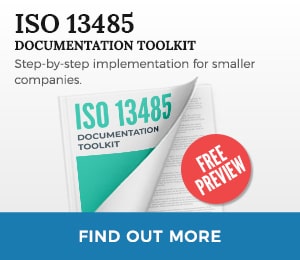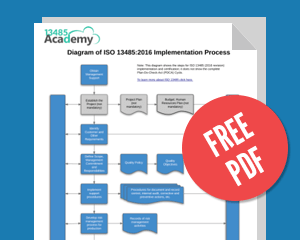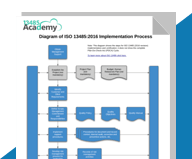Organizations sometimes go too far with their quality manual, creating a huge, unusable book that is pretty much just the ISO 13485 standard rewritten with all the “you shall” language changed to “we will.” I suppose that technically, this would show written evidence that the organization is committed to meeting every single requirement the standard lists for their Quality Management System (QMS) – but a document like this is much too long and difficult to understand to be of any use to employees. Many modern companies like to go with a short, graphical manual that’s easy to read and understand. So, what do you actually need to include in your quality manual?
What does ISO 13485 require from the quality manual?
To begin, we’ll look at the requirements of a quality manual, and the thinking behind each requirement:
1) The QMS scope. This is a description of what your company does (e.g., Distribution of Medical Devices, Software Design for MRI Machines, etc.) and the boundaries of your Quality Management System. It needs to be agreed upon with the certification body, as it will be stated on the ISO 13485 certificate.
Now that you have what’s included in your scope, you need to list any exclusions from the standard. Oftentimes, there won’t be any to list, but a common exclusion is the “Design and Development” clause of the standard, because many companies manufacture products according to customer specifications, and don’t actually design any products.
2) Documented procedures. There are quite a lot of procedures that ISO 13485 requires an organization to document (or at least reference) in the quality manual. Mandatory documented procedures include:
- Control of documents
- Control of records
- Internal audit
- Control of non-conforming products
- Corrective and preventive actions
- Validation of computer software
- Customer specifications (for manufacturing, inspection, packaging, and delivery)
- Monitoring and measurement
- Servicing and installation (if applicable)
- Management review
- Work environment and contamination control
- Design and development
- Validation of sterilization and sterile barrier systems (if applicable)
- Identification and traceability
- Preservation of product
- Calibration or verification for measuring equipment
- Feedback and complaint handling
- Reporting to regulatory authorities
- Advisory notices, reworks, data analysis
In addition to these required documents, there is a requirement for companies to develop documentation for any procedures that are likely to have non-conformances were they not written down. Basically, if you need a documented procedure to prevent mistakes from occurring, then you need a documented procedure. Procedures that are shown graphically, like flowcharts, can be included right in the quality manual. For longer procedures that require more written information, it’s simpler to include references to these documents in the quality manual. In this way, the quality manual can serve as a kind of quick-reference guide to company procedures.
3) Descriptions of processes and their interactions. The easiest way to accomplish this is with a simple, top-level flowchart illustrating the basics of your organization’s processes, with arrows showing how they interact. You don’t need to go into great detail for this in the quality manual.
What other reasons do we have to keep it short?
An added benefit of a short, illustrated quality manual is that you can use it as an attractive brochure to show to potential clients. Instead of re-stating all the long, difficult text of the ISO 13485 standard, use this extra space for nice features like your Mission and Vision statements, your quality policy, quality objectives, etc. These kinds of extras are appealing to customers who want to buy from you, and will clearly show how you can best meet their needs. You might even want to include a simple organizational chart to show your company’s management structure.
What do you want to show your customers?
It’s become fairly common for a company to ask to see the quality manual of a supplier they are considering partnering with. They want to be sure that you have everything needed for an effective Quality Management System, even before they look at your abilities to meet their business needs. So, what do you want them to see? A large document that takes two people to carry, and a month to read? Or colorful, easy-to-scan informational brochure that sets your organization apart from the competition?
For a graphical representation of the implementation process, check out this free Diagram of ISO 13485:2016 Implementation Process.

 Waqas Imam
Waqas Imam 




